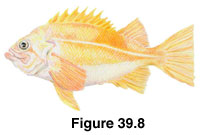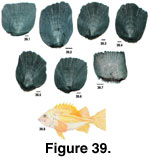 Description
Description
Sebates pinniger
(Canary Rockfish)
(Other common names: Orange Rockfish, Fantail Rockfish, Red Snapper)
Figure 39.8
 Description
DescriptionLength: 76 cm.
Mouth: large, terminal; lower jaw projects but not into head profile; upper jaw extends to posterior of orbit; symphyseal knob weak; lower jaw had dentary elevations.
Body: coronal and nutchal spines absent; all other head spines weak; five preopercular fine and thin; opercular spines long; cleithral and supracleithral both well developed; caudal fin indented; intraorbital space convex; scales on underside of jaw are smooth.
Color: gray with orange or orange and yellow mottling; pale below; orange fin membranes; dark area on spinous dorsal fin; small individuals may have black speckling; three orange head stripes radiating to opercular slit.
Depth: 100-375 m; young in shallower waters; adults shallower in northern waters.
Habitat: hard and soft substrates; demersal schooling species.
Season: ovoviparous; spawn in mid-fall; young released in later winter-early spring.
Diet: small crustaceans (e.g., krill), forage fish (e.g., herring, anchovies).
Predators: not determined.
Distribution: Baja, California to Alaska; populations in British Columbia waters are separated into West Coast Vancouver Island stock and a Queen Charlotte Sound stock.
 Scale Description
Scale DescriptionRelative Scale Size: large.
Position of Scales on Body: diagonal rows below lateral line canal 43-50 (Hart, 1973).
Overall Shape: the scales are generally square, but differential elongation can make the anterior/lateral margins appear bulging. The posterior field is short. The lateral fields can appear gently crenulated in some specimens.
Focus and Circuli: the focus abuts the edge of the posterior field, along the edge of ctenii growth. The focus is one-seventh of the total scale. Length is from the outside edge of the posterior margin. The circuli are continuous between the lateral and anterior fields (except broken by radii).
Radii: numbers are variable and not diagnostic. Present only in the anterior field. The outer edge of the anterior field is straight to convex and is moderately to strongly scalloped.